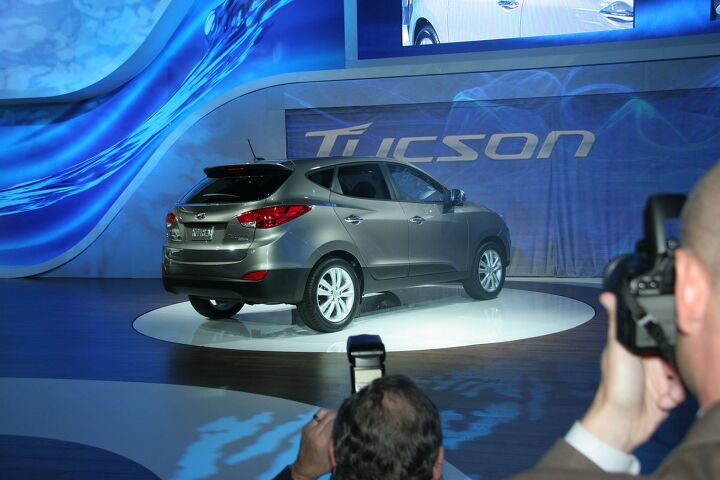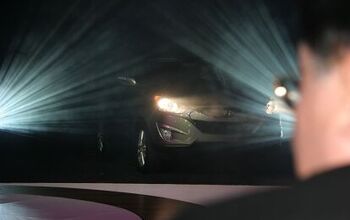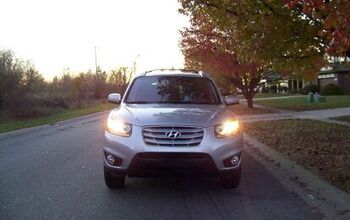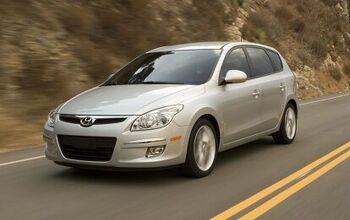Review: 2010 Hyundai Tucson
When Hyundai introduced its first Tucson in 2004, the term crossover still hadn’t crossed over from the world of marketing into the public imagination. At the time, the term SUV still carried enough equity to convince even the ute-lets built on compact car platforms to emphasize their rugged inspiration with upright, boxy styling and spartan utility. These car-based “cute-utes” were, according to the logic of the time, for consumers who wanted in on the SUVs alleged lifestyle enhancements without the profit-swelling sticker shock and ruinous fuel bills. Today, the crossover has properly crossed over, leaving behind the pretensions of the SUV-weaning generation to assume its own identity in the automotive market. For better or for worse, the new Hyundai exemplifies this new state of the crossover, and it makes the case for itself without reference to its previous status as a cheap substitute for an SUV.
Where other recent Hyundais have built the company’s reputation by taking laser-guided aim at American market hits like the Toyota Camry and Lexus LS, the Tucson’s roots are traceable to the spiritual home of the compact crossover: Europe. Designed and developed in Germany, where it will be
sold as the Hyundai iX, the Tucson moves Hyundai’s crosshairs away from its traditional target on Toyota’s back towards Nissan’s European hit crossover, the Qashqai (a variant of which is sold in the US as the Rogue). The Tucson’s passenger dimensions are on-par with Rogue, Toyota’s RAV4 and Honda’s CR-V (with about 40 inches of headroom front and back, 41 inches of legroom in front and 38 inches in back), but cargo space comes in below all of its competition (but closest to the Rogue) with only 25/55 cubic feet with the rear seats up/down.
But fixating on practical numbers isn’t what the new crop of crossovers is about. If car buying were as simple as number-crunching, Hyundai’s Elantra Touring would cannibalize the new Tucson before it even arrived, offering similar dimensions and nearly identical mileage at a lower price point. Luckily for the auto industry, the emotional appeals that once sold SUVs by the boatload are hard at work in the new crossover class, and luckily for Hyundai, the Tucson hits all the notes needed to convince a buyer to abandon the rational analysis that might send them home with a mere station wagon.
The Tucson’s styling is some of the best in the compact CUV class, offering a taut, sculpted, sophisticated look that owes nothing to the crossover’s SUV-lite genesis. Which is not to say that the Tucson lacks stylistic debt: its “Fluid Sculpture” design language is more than a little reminiscent of Ford’s “Kinetic” aesthetic, making the Tucson something of a larger, less restrained Ford Kuga. In a US-market segment that boasts styling ranging from the timelessly anodyne (CR-V) to the faux-butch (Ford Escape) to the just-plain-uninspired (RAV4, Rogue, Equinox), the Tucson can expect to get good mileage from its distinctively European looks.
Especially considering that the impression of German world-car values continues inside. The center console is clean and clutter-free, with just enough funky flair from its flanking air vents and detached HVAC controls to prevent a sterile, industrial aesthetic. Interior design is more similar to the Chevy Equinox than the grey-plastic wonderlands of its Japanese competition, but unlike the Equinox, a sense of German propriety keeps the design from overshadowing its execution. Faux-alu plastic is blessedly kept to a minimum, while the solid swaths of dash material are well-arranged, tolerable to the touch, and seemingly set in concrete.
Though the interior walks the line between bland competence and Euro-sophistication, the drivetrain falls solidly on the side of bland competence. The good news is that the 2.4 liter engine’s smooth, if characterless performance, helps the Tucson deliver a quiet impression of isolation that actually adds to the sophistication side of the ledger. The less good news is that the engine itself is entirely unremarkable, developing its 176 horsepower without much in the way of drama, noise, or excitement. Hyundai’s in-house, six-speed automatic transmission is similarly lacking in defining characteristics, shifting smoothly if not snappily. Considering the distinct shortage of enthusiast options in this segment, this smoothed-out, inoffensive, and just-plain competent drivetrain isn’t likely to be a sales liability (and a turbo option is rumored).
Given the Tucson’s appliance-like drivetrain, there was no reason for Hyundai not to equip it with a soft, cruising suspension and call it a day. At least not if, like the RAV4 and Equinox, it were developed specifically to appeal to the US market taste. Instead, the suspension is remarkably taut, delivering a firm, pinned-down ride. The downside, of course, is some roughness over poorly-paved roads, but the combination of good damping and an impressively stiff body keep these disturbances feeling remote and manageable. Electric power steering helps the AWD Tucson to its 21/28 mpg EPA numbers just as much as it adds to this sense of remote isolation, but at the obvious expense of any road feedback through the wheel. Though it matches the drivetrain’s appliance-like competence and isn’t the most egregiously inconsistent EPS setup we’ve driven, the shockingly
able suspension cries out for a more connected helm.
Not that anyone in the Tucson’s target market will care. With prices for FWD, manual models starting below $19k, and fully loaded Limiteds (pictured) topping out under $30k, it’s more fun to drive, more stylish and and more affordable than most of its Japanese and American competition. Our AWD GLS tester with the $1,700 “popular equipment package” offers the Bluetooth, steering wheel controls, leatherette accents, and a host of other items for a whisker under $24k. Which is about where no-option, AWD versions of its (slightly larger) competitors live. It won’t tempt anyone who still drives an SUV down into the burgeoning crossover class, but it certainly makes a strong rational case for itself to buyers with a Rogue or RAV in their sights. Heck, as an emotional, stylish design, it might even tempt a few otherwise reasonable folks out of an Elantra Touring. How the crossover has changed.
More by Edward Niedermeyer
Latest Car Reviews
Read moreLatest Product Reviews
Read moreRecent Comments
- Kwik_Shift_Pro4X Mazda CX-5 all the way.
- Spookiness The Mazda interior really is nice. I recognize the rationale for the Mazda infotainment interface design in lieu of a touch screen, but the filthy masses have spoken. As with the rotary engine, it's time to move on. To sell more cars they'll need to have touchscreens. Other carmakers have evolved beyond the iPad-screwed-on-top-the-dash look, so I'm sure Mazda can come up with something aesthetically pleasing and user-friendly. (Another quibble: I really don't need or want AWD, so I wish it wasn't forced. But again, the masses have spoken.)
- Lou_BC “We are always listening to the customer. "You sayin' the baller/gangsta types don't want Escalades on 24's that don't make vroom vroom rumbly sounds?
- AZFelix I shall fully endorse the use of autonomous cars on public roads once they have successfully completed my proposed Turing test for self driving vehicles. This test requires the successful completion of an at fault incident and accident free 24/7 driving session in Buffalo and upstate New York from October 1st until March 31st, and throughout the city of Jakarta, Indonesia for one consecutive year. Only Level 1 and Level 5 vehicles are permissible.
- Lou_BC I'd go Rav4. No Mazda dealer in my town and from what I've seen, Mazda's tend to rust.






































Comments
Join the conversation
We test drove several CUVs this past weekend, for my wife. She is moving from a Golf MkIV. The Tucson was a good mix. Decent storage. Seat-down capacity was within a few cubic feet of Rogue and CX7. Nice option package. What really sealed it was the dynamite stereo and all its capability. It was just short of SYNC. And it did look really good in person. It was the only new CUV that we could afford with our desired options. Otherwise it has to be a used car. With that price/option conundrum, what really tips the scales is the warranty. You get Honda repair peace-of-mind at Chevy prices. The Mazda CX7 was nice, but without leather it’s a big thick sedan that doesn’t feel especially premium. The large center console is waste of space. The CRV was too firm. Even the loaded EX-L could not shake the minimalism. Everything felt a bit thin, especially compared to the VW. I really, really, wanted to like the CRV. RAV-4 was way too numb. Great rental car after a hard flight, but really bland. Escape was very dated in driving dynamics. Tippy. However, it was my favorite because it could tow. But this is not my car.
I was driving my new loaded Diamond Silver 2010 Tucson Limited and I passed a brand new Mercedes GLK –Class SUV on the freeway and he sped up to check out my ride, he just kept looking and looking. I turn around and smiled, thinking what a fool, my car looks better, I’m getting better MPG’s and I paid about half the price. If you know anything about cars you have to like the looks and you can’t beat the warranty. Watch out Hyundai’s coming up big time…